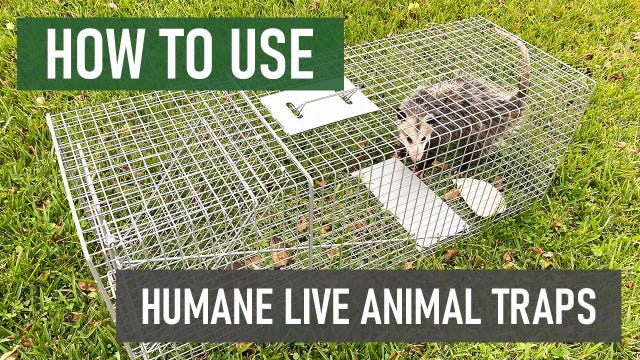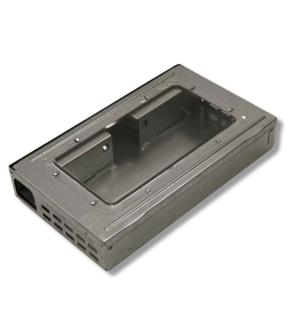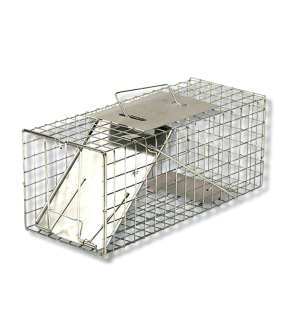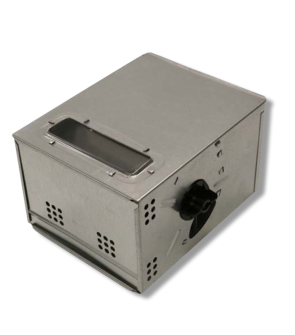Gain access to personalized product screening, the best pricing, rewards, and more!
Most Effective Products
Live Trapping
Wild animals can be complex to manage once they enter your home or property. They can also cause much damage, so it’s best to act quickly once you discover a problem. Standard methods to control wild animals are snap traps, glue boards, and poison bait.
While the methods listed above can be effective for removing pest animals, not everyone wants to use these types of products. We at Solutions Pest & Lawn understand that which is precisely why we have humane live-trapping techniques and products that can capture rodents and animals without harming them.
What is Live Trapping?

Live traps capture unwanted rodents and animals from structures, lands, and areas via humane means, which results in the animal not being harmed. Once caught by a live trap, the offending creature is transferred to another location and safely released back into the wild rather than killed.
Live traps are good for capturing smaller rodents like mice as well as larger animals like squirrels, raccoons, foxes, woodchucks, and similar animals that can trespass onto a property and cause damage.
Live traps often involve various styles and mechanisms that lure, trick, and seize the critter. For instance, there are single-door traps, rear-door traps, and collapsible two-door traps. In rodents like rats and mice, there are also traps where multiple captures can be achieved. We’ll touch on a few of them here:
Single-door traps -These traps have only one spring-loaded door at the front; baiting, setting, and releasing the animal are carried out through this single door. They are simple to operate and safe to use around children and pets.
Rear-door traps—This type of live trap features two doors—one in the front and another at the rear. Baiting and releasing the animal are done through the sliding rear door while setting can be done through the spring-loaded front or rear door. This type of trap allows quick access to bait and set it and safe release of the captured animal; it's ideal for aggressive animals. The rear door is equipped with a double latch and security lock.
Multiple-Capture Traps - These traps are primarily for smaller rodents like mice. The benefits of multiple-capture mouse traps are their ability to operate for long periods without the use of bait and to reset themselves. High-profile, wind-up types utilize a spring-operated paddle wheel to throw captured mice into a compartment. Low-profile, non-wind-up types use a series of tunnels and treadles that allow mice to enter but not leave. Mice enter multiple-capture traps because they tend to investigate new holes in their territory.
Conditions to Use Live Traps
Live traps can be used in food plants, kitchens, restaurants, food processing plants, hospitals, residences, zoos, and other sensitive areas where poison is prohibited or discouraged.
Customers who prefer to use live traps often do so because it is a relatively cheap, quick, and easy method of capturing mice, rats, or other insects that have infested their homes or places of business and are more humane.
It can be hard to go on the hunt and inspect for pests, so live traps often do the work for you by capturing the offending pest so that you can release it.
Benefits of Live Traps
The main benefit of live traps is that they are a safer and more humane method of capturing an animal or rodent. Once the animal is captured, it can be safely released back into the wild.
Drawbacks of Live Traps
Using a live trap does not guarantee a trapped animal. Raccoons, in particular, can be known as "cage-wise," meaning they know what a cage is and will avoid it.
Our Recommendations
Solutions Humane Live Animal Trap—This trap is ideal for squirrels, skunks, stray cats, and ground hogs. It is made of sturdy, rust-resistant wire mesh and steel reinforcements, and it will provide years of reliable trapping.
Multi-Ctach Mouse Trap—This trap catches mice alive so they can be removed from homes or businesses. It is discreet, easy to use, efficient, and safe around pets and kids.
Repeating Humane Mouse Trap—This is a multi-catch mouse trap used to catch mice of all sizes and shapes while they are still alive. It can be wound up and catch up to 13 mice without being reset. It is great for use in farms and warehouses where large quantities of mice must be caught. It is non-lethal.
Tools Needed
Wear the proper personal protective equipment (PPE) before handling a live trap. Gloves need to be worn at all times to avoid leaving your scent behind. Animals will avoid an area that has a human scent, making your trap ineffective.
As a result, bait is also needed to lure the wild animal into the trap.
User Guide
Live traps rely on optimal placement, sanitation, and exclusion. When food and harborage are removed, rodents move in search of these resources, making them vulnerable to traps.
Step 1: Bait the Trap
Place the bait in the trap before setting it. The type of bait you use will depend on the wild animal you are trying to catch. For a generic bait, use peanut butter. It is a cheap product, and many animals enjoy it. You can also read our guide on how to bait a live trap.
Step 2: Set the Trap
Once you have inserted the bait, you can set the trap. The process for setting the trap depends on the model of live trap you are using. The trap will need to be placed in an area with high animal activity, which will increase your chances of catching an animal.
Step 3: Release the Animal
Once the animal is captured, you can proceed with transfer and release. It is important to release a wild animal in an appropriate habitat that provides sufficient resources for survival. Before handling the live trap, you need to contact your local animal control and find out if there are any laws about releasing an animal. Generally, you will want to release the animal at least 20 miles from your property so they do not return.
Always use extreme caution when releasing, transferring, or moving a trapped animal. Wear heavy leather or padded gloves, a shirt or jacket with long sleeves, and long pants to avoid being scratched or bitten. You can also place a towel over the cage so you do not frighten the animal when relocating it. Trapped animals – wild or domestic – can be unpredictable, so be prepared for any response. Some animals will quickly bolt out of the trap, while others may slowly leave.
Key Takeaways
- Live traps are a safe and effective control method for capturing and releasing wild animals that have invaded your home or property.
- Traps will produce maximum results when they are baited correctly and placed in areas with high activity from pest animals.
- The Solutions Humane Live Animal Trap and the Multi-Catch Humane Mouse Trap are among the best live traps for capturing intruding rodents and animals and have a convenient release method.
Solutions Pest & Lawn is home to a number of professional-quality live humane traps that can capture and subdue wild animals. On this page, you will learn about live trapping, the pros and cons of using humane traps, and how to properly apply live traps around your property to treat rodents and animals. You can also shop the best humane live traps we carry in stock.









